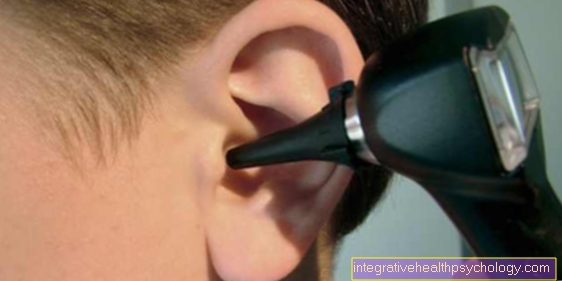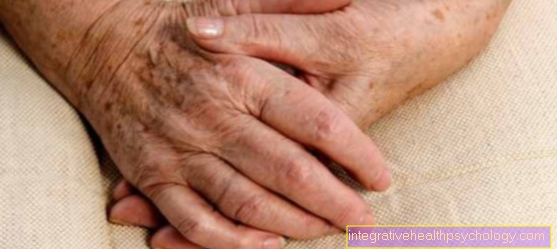Boils on the leg
General
A boil is an inflamed hair follicle (structures that surround the hair follicle and anchor the hair to the skin). The hair follicle and the surrounding tissue are both purulent and painfully inflamed. In some cases, several neighboring boils can also merge into a so-called carbuncle.
If boils occur more frequently over time, one speaks of furunculosis, the cause of which should be clarified in any case. A typical location for a boil is the thigh (the face, neck, armpits, buttocks and genital area are also typical). In principle, however, any hairy part of the body can be affected.

Inflammation occurs on minimally injured areas of the skin due to a bacterial infection, which occurs mainly in people with a weakened immune system. In most cases, the pathogen is Staphylococcus aureus.
The thigh is considered to be an exposed point for the development of a boil, since boils tend to develop in places where there is a lot of friction or increased sweating. The friction causes skin damage, making it easier for bacteria to penetrate. This happens especially with tight-fitting trousers on the thigh, or with the tight-fitting sock waistband on the lower leg.
Read more at: Boils on the thigh
Underwear with leg ends that are too tight should also be avoided, as the friction that occurs in the skin folds on the thighs (and also under the armpits) causes boils to form.
Another reason for frequent placement on the leg is that inadequate disinfection is more common for boils to develop after shaving.
Otherwise, another beneficial factor is an existing or still unknown sugar disease (diabetes mellitus).
causes
Boils on the leg are one of the so-called soft tissue infections. Apart from boils, other diseases, such as carbuncle and folliculitis, are also soft tissue infections. A preferred localization of boils are the thighs and the genital and anal areas. Boils arise where hair follicles are located. Men, who naturally tend to have thicker hair, are particularly affected.
A boil on the leg occurs when the hair follicle becomes infected with bacteria. The most common pathogen is the bacterium Staphylococcus aureus. So-called streptococci are less common as causative pathogens. People who are prone to atopic eczema - also known as neurodermatitis - or diabetes mellitus are particularly at risk. Both diseases lead to the skin's immune defense being weakened, which means that soft tissue infections such as boils can occur more frequently. Furthermore, a warm, humid climate and poor hygiene can promote eczema.
Appearance and symptoms of a boil
Before the actual boil develops, a pus-filled vesicle or pustule forms in the center of the inflammation.
On closer inspection, a small hair can be seen in the middle of the pustule, in the center of a swelling. (Boils are caused by inflammation of a hair follicle). Then, when the inflammation spreads to neighboring tissue, the actual boil develops, which increases in size during the process.
A boil is usually half a centimeter to two centimeters in diameter. A pressure-sensitive, tightly elastic knot forms.
In the course of the ripening process, a purulent meltdown occurs and the tissue in the middle of the knot dies off, which is technically known as necrosis designated.
When the boil eventually breaks through the skin, the pus will drain. A small, indented scar remains after the healing process.
If the course is free of complications, boils are usually not accompanied by additional symptoms. In rare cases, mild general symptoms such as increased temperature can occur.
The pathogens are surrounded by a kind of capsule inside the boil, so that they are protected from attacks by the immune system.
diagnosis
After physical examination of the skin must still be a clear diagnosis Smear of the boil be taken.
This smear can be used in the event of a boil detect bacterial pathogens. If you cannot detect a bacterial pathogen, it is not a boil.
In most cases, a boil is caused by the bacterium Staphylococcus aureus. Furthermore, if it occurs frequently, the Blood sugar level measured again because it is not set and therefore not yet known Sugar disease promotes the development of boils.
You might also be interested in: Furunculosis
Should I express the boil on the leg?
A boil on the leg should never be expressed, as this can lead to significant complications, such as systemic infections or abscesses up to sepsis. The manipulation, i.e. pressing or scratching on, a boil should be strictly avoided.
treatment
In most cases, boils will heal on their own without further treatment or complications.
It is important to note that you do not express the boil under any circumstances.
Since it is easily mistaken for a common pimple, this is often done incorrectly. Because if the boil is not yet fully developed, the pus can empty inwards instead of naturally occurring afterwards, which in the worst case can lead to blood poisoning, which if left untreated is life-threatening.
When treating a boil, it is particularly important to pay attention to hygiene so that the boil or the pathogen does not spread to other parts of the body. Especially if the boil bursts naturally during healing, as the content is highly infectious.
After each touch of the boil, you should always clean / disinfect your hands thoroughly. Due to the risk of spreading, you should avoid baths and shower instead.
Towels and bed linen should be washed at high temperatures.
The widespread and widely used pull ointment, which has, among other things, blood circulation-promoting, anti-inflammatory and pain-relieving properties, should not be used to treat a boil.
The application promotes the maturation of a boil, but leads to the development of an abscess on the leg, which then has to be surgically removed.
Since it is a bacterial infection, an antibiotic is rarely used to combat it.
Heavy skin disinfection is usually used to treat a straightforward boil. Furthermore, warm and moist compresses are used, as the boil is spontaneously emptied by the moist heat and then healing occurs.
In the case of particularly painful boils or a boil that does not open by itself, this can be opened with a scalpel so that the pus can be removed. The operation of a boil takes place under local anesthesia and is then given further medical treatment.
Read more on this topic at:
- Treatment of a boil
- Ointment for a boil
Antibacterial aftershave balms can also help disinfect and soothe the skin. This is especially true after hair removal. One example of this is the Dr. Severin Body After-Shave Balm from the pharmacy.
Complications from a boil
As a rule, a boil is not accompanied by other symptoms in addition to the local discomfort.
However, if a carbuncle develops from several boils, stronger general symptoms (including fever) often occur. In some cases the lymphatic system becomes inflamed, which in turn leads to swelling of the neighboring lymph nodes. With a boil on the leg, the lymph nodes in the groin and in the hollow of the knee are particularly affected in this case.
It becomes dangerous when the pathogens penetrate the bloodstream, which leads to dangerous blood poisoning (sepsis).
In contrast to a boil in the facial area (possible site-specific complications: meningitis and cerebral vein thrombosis), a boil on the leg cannot lead to dangerous complications.
You may also be interested in this topic: Abscess on the inside of the thigh
Duration
The duration of a boil can vary from person to person. Most often, boils develop acutely over a few hours. They can last for days or even weeks and often drain pus spontaneously. This spontaneous evacuation of pus can also occur after a few days or weeks, depending on the boil. The boil should never be pushed open, as this does not promote healing, but can cause an abscess.
With small boils on the leg, local therapy with disinfecting compresses and topical pull ointments is often sufficient to achieve healing after a few days. On the other hand, more pronounced boils on the leg require systemic therapy with antibiotics in order to achieve healing.
Also read the article: The duration of a boil.
Recommendations from the editorial team
You can find more information on the subject of stonework here:
- Main article boils
- Treatment of an abscess
- Duration of a boil
- Causes of a boil
A list of all the topics related to dermatology that we have already published can be found at: Dermatology A-Z



.jpg)

























